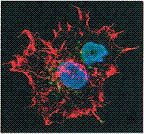Biochemistry, Department of

Gautam Sarath Publications
Document Type
Article
Date of this Version
2009
Abstract
Knowledge of the physiological responses of barley, Hordeum vulgare L., to the Russian wheat aphid, Diuraphis noxia (Mordvilko) (Hemiptera: Aphididae) is critical to understanding the defense response of barley to aphid injury and identifying resistance mechanisms. This study documented the impact of D. noxia feeding on resistant (‘Sidney’) and susceptible (‘Otis’) barley through chlorophyll fluorescence measurements, chlorophyll content, and carbon assimilation (A–Ci) curves recorded at 1, 3, 6, 10, and 13 days after aphid introduction. All chlorophyll fluorescence parameters evaluated were similar between aphid-infested and control plants for both cultivars. A–Ci curves showed that D. noxia feeding negatively impacts the photosynthetic capacity in both cultivars, but this effect was greater in the susceptible plants. From the A–Ci curves, it is apparent that compensation occurs in resistant barley by day 10, but by the conclusion of the experiment, aphid populations reached levels that overwhelmed the resistant barley seedlings. Differences observed in carbon assimilation curves between control and infested plants show that D. noxia feeding impacts the dark reaction, specifically rubisco activity and RuBP regeneration. It is likely that declines in the photochemical efficiency and chlorophyll content of the plants may be a secondary effect and not the primary trigger of declines in host plant function.


Comments
published in Arthropod-Plant Interactions, 2009. Copyright (c) Springer Science+Business Media B.V. 2009. Used by permission.